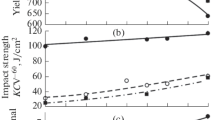Abstract
Based on the results of phase physicochemical analysis of high-carbon chromium–vanadium steel, the predominant type of carbide that provides high wear resistance has been established, and its amount and amount of carbon in martensite have been determined. Data on the composition and the amount of carbide phase and on the chemical composition of the martensite of high-carbon steel have been obtained, which allows determination of the alloying-element concentration limits. The mechanical testing of heats of a chosen chemical composition has been carried out after quenching and low-temperature tempering. The tests have demonstrated benefits of new steel in wear resistance and bending strength with the fatigue strength being retained, compared to steels subjected to cementation. The mechanism of secondary strengthening of the steel upon high-temperature tempering has been revealed. High-temperature tempering can be applied to articles that are required to possess both high wear resistance and heat resistance.
Similar content being viewed by others
References
E. N. Kablov, “Innovative developments of FSUE “VIAM” SSC of Russian Federation on the realization of “Strategic directions of the development of materials and technologies of their processing for the period until 2030”,” Aviats. Mater. Tekhnol., No. 1, 3–33 (2015).
E. N. Kablov, “Modern materials as the basis of the innovation modernization of Russia,” Metally Evrazii, No. 3, 10–15 (2012).
E. N. Kablov, B. S. Lomberg, and O. G. Ospennikova, “Creation of modern refractory materials and technology of their production for aviation propulsion engineering,” Kryl’ya Rodiny, Nos. 3–4, 34–38 (2012).
E. N. Kablov, O. G. Ospennikova, and O. A. Bazyleva, “Materials for parts of gas-turbine engines under high heat loads,” Vestnik Mos. Gos. Tekhn. Univ., Ser. Mashinostr., No. SP2, 13–19 (2011).
E. N. Kablov, “Developments of All-Russia Institute of Aviation Materials for gas-turbine engines and plants,” Kryl’ya Rodiny, No. 4, 31–33 (2010).
Yu. N. Shmotin, R. Yu. Starkov, D. V. Danilov, O. G. Ospennikova, B. S. Lomberg, “Novel materials for perspective engine of PC SPA “Saturn”,” Aviats. Mater. Tekhnol., No. 2, 6–8 (2012).
E. N. Kablov, “Materials for the “Buran” spaceship— Innovative solutions for the formation of the sixth technological mode,” Aviats. Mater. Tekhnol., No. S1, 3–9 (2013).
V. I. Gromov, N. A. Kurpyakova, O. V. Sedov, and E. N. Korobova, “Vacuum and ion–plasma chemical–thermal treatment of critical gas turbine engine components,” Aviats. Mater. Tekhnol., No. 5, 147–155 (2012).
O. A. Tonysheva, N. M. Voznesenskaya, A. B. Shal’kevich, and A. F. Petrakov, “Effect of hightemperature thermomechanical treatment upon the structure, technological, mechanical and corrosion properties of high-strength corrosion-resistant steel of transition class with an enhanced nitrogen content,” Aviats. Mater. Tekhnol., No. 3, 31–36 (2012).
O. A. Tonysheva, N. M. Voznesenskaya, E. A. Eliseev, and A. B. Shal’kevich, “Novel high-strength efficiently- alloyed nitrogen-containing steel of improved reliability,” Aviats. Mater. Tekhnol., No. 5, 84–88 (2012).
L. V. Tarasenko, V. I. Titov, and A. N. Utkina, “Phase analysis of high-carbon steel for gears and punches produced without chemical-heat treatment,” in Proc. 5th Int. Conf. “Topical Problems of Materials Science in Metallurgy” (Novokuznetsk, 1997), p. 44.
L. V. Tarasenko, V. I. Titov, A. N. Utkina, and A. B. Shal’kevich, “High-carbon structural steel for gears and tools of enhanced wear-resistance without surface chemical-heat treatment,” in Proc. Int. Conf. “Advanced Technologies on the threshold of the 21th century” (Moscow, 1998), p. 54.
L. V. Tarasenko, A. N. Utkina, V. I. Titov, A. B. Shal’kevich, and N. N. Popov, “Novel steels for tribo-conjugations in geodesic devices,” in Proc. Int. Sci.-Techn. Conf. devoted to the 220th Anniversary of the MIIGAiK (MIIGAiK, Moscow, 1999), p. 18.
L. V. Tarasenko and V. I. Titov, “The nature of secondary hardening of high-carbon chromium–vanadiium steels,” in Proc. 15th Ural. School of Metallurgists–Thermists (Ekaterinburg, 2000), p. 43.
L. V. Tarasenko and V. I. Titov, “Role of phase physochemical analysis in the development of highstrength and refractory steels of aviation destination,” in Proc. Int. Sci.-Pract. Conf. dedicated to the 100th Anniversary of the Birthday of Academician S.T. Kishkin “S. T. Kishkin’s Scientific Ideas and Contemporary Materials Science” (Moscow, 2006), pp. 180–189.
L. V. Tarasenko, V. I. Titov, and A. N. Utkina, “Heterophase high-carbon structural material,” in Proc. 3rd Euro-Asian Sci.-Pract. Conf. “Hardness of Heterogeneous Structures” (Moscow, 2006), p. 62.
L. V. Tarasenko, V. I. Titov, and A. N. Utkina, “Properties and phase composition of high-carbon steel for aircraft gears,” Metallur. Mashinostr., No. 3, 10–14 (2012).
V. M. Schastlivtsev, Yu. V. Kaletina, E. A. Fokina, and A. Yu. Kaletin, “On the role of retained austenite in the structure of alloyed steels and the effect of external factors,” Phys. Met. Metallogr. 115, 904–917 (2014).
V. M. Schastlivtsev, Yu. V. Kaletina, and E. A. Fokina, Residual Austenite in Alloyed Steels (Ural. Otd. Ross. Akad. Nauk, Ekaterinburg, 2014) [in Russian].
V. I. Titov, L. V. Tarasenko, A. N. Utkina, and A. B. Shal’kevich, “Phase physico-chemical analysis in the development of novel composition of high-strength structural steel for aviation-related applications,” Zavod. Lab. Diagn. Mater. 81, 35–39 (2015).
Author information
Authors and Affiliations
Corresponding author
Additional information
Original Russian Text © V.I. Titov, L.V. Tarasenko, A.N. Utkina, 2017, published in Fizika Metallov i Metallovedenie, 2017, Vol. 118, No. 1, pp. 85–90.
Rights and permissions
About this article
Cite this article
Titov, V.I., Tarasenko, L.V. & Utkina, A.N. Effect of alloying elements on the composition of carbide phases and mechanical properties of the matrix of high-carbon chromium–vanadium steel. Phys. Metals Metallogr. 118, 81–86 (2017). https://doi.org/10.1134/S0031918X17010070
Received:
Accepted:
Published:
Issue Date:
DOI: https://doi.org/10.1134/S0031918X17010070




